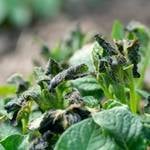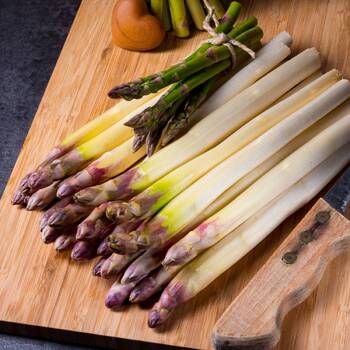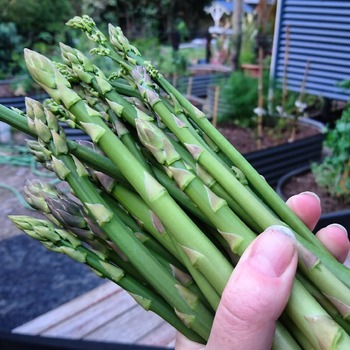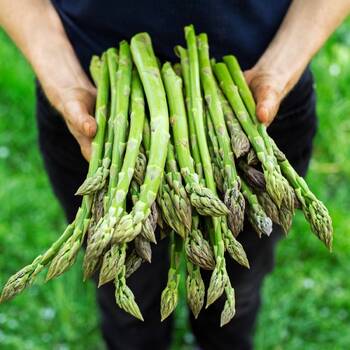
How to Grow Asparagus Seeds
Grow Guide #2228
Family: Asparagaceae
Binomial name: Asparagus officinalis
Life Cycle: Perennial
This 'How to Grow' guide details everything a home gardener needs to know to plant, grow and care for Asparagus (Asparagus officinalis).
(This guide provides instructions on how to grow Asparagus from seed. Asparagus can also be grown from crowns, the year-old roots and rhizomes of plants that are dug up and sold bare-rooted (without soil). To learn how to grow asparagus from crowns, click here.)
When to Sow Asparagus Seeds
Asparagus is a perennial plant that grows year round in most climates. Use the table below to identify the best time of year to sow asparagus seeds in your climate.
| JAN | FEB | MAR | APR | MAY | JUN | JUL | AUG | SEP | OCT | NOV | DEC | |
|---|---|---|---|---|---|---|---|---|---|---|---|---|
| Cool | ||||||||||||
| Temperate | ||||||||||||
| Sub-Tropical | ||||||||||||
| Tropical | ||||||||||||
| Arid |
Preparation
Asparagus plants are perennial, meaning they live for several years. Choose a permanent position where plants can grow undisturbed by regular digging.
Asparagus plants are best grown in full sun or part shade. Choose a location that will receive at least 3 hours of full sun each day.
Asparagus plants need a well drained soil enriched with plenty of organic matter. Prepare soil by weeding it thoroughly, digging it over to loosen it and adding aged animal manure or compost. Keep the area free of weeds until planting. Learn more about preparing soil for planting here.
How to Sow Asparagus Seeds
Asparagus seeds do not require any treatment (eg soaking, stratification) before sowing.
Asparagus seeds can be sown directly into the garden OR seedlings can be raised in trays or other containers and transplanted to the garden once established.
Sow Direct
- Sow seeds directly in the garden 10mm deep and 20-40cm apart, with rows 100cm apart.
- Keep soil moist but never wet or dry.
- Seeds should germinate in around 14-21 days at a soil temperature of 23-27°C.
- Young seedlings will need protection from pests, pets and weather until they are established.
Raise Seedlings
- Fill trays, punnets or jiffy pots with a good quality seed-raising mix, or use soil starter pellets.
- Sow seeds 10mm deep.
- Keep soil moist but never wet or dry.
- Seeds should germinate in around 14-21 days at a soil temperature of 23-27°C.
- Transplant seedlings to the garden once they have their first true leaves and are large enough to handle (usually 5-10cm tall).
- Plant out, spacing plants 20-40cm apart, with rows 100cm apart.
Asparagus is a tender crop that’s sensitive to frost. Do not transplant seedlings or sow seeds outside until all danger of frost has passed.
Optional: In cool climates asparagus seeds can be sown indoors 6 weeks before the last expected frost. Grow them in a warm position with plenty of natural light.
How to Grow Asparagus
Asparagus plants may need watering during the growing season. Water when the soil is dry about 5cm below the surface (test this by scratching away a little soil with your finger). Water deeply in the early morning or late afternoon. Avoid watering the leaves of plants to avoid fungal diseases. Learn more about watering here.
If soil was well prepared no extra fertiliser should be necessary. In poor soil or to give your plants an extra boost, application of a balanced fertiliser or one formulated for fruit and vegetables can be beneficial:
- Apply slow release fertiliser at the recommended rate when transplanting or when seedlings are 5-10cm tall.
- Apply liquid fertiliser at the recommended rate and frequency while plants are fruiting or flowering.
Asparagus grown from seed will produce both male and female plants. Female plants produce inedible red berries. The males generally produce thicker spears, so female spears should be removed unless they're grown for seed saving.
The foliage of asparagus plants will yellow and begin to die down during autumn or early winter. Cut off the foliage just above ground level, apply compost or balanced fertiliser and a thick layer of mulch to protect plants over winter.
Asparagus plants can be blanched to improve tenderness and flavour. Exclude light around plants by hilling soil up around their bases, mulching thickly with straw or placing opaque containers around the plant. Learn more about blanching here.
How to Harvest Asparagus
Asparagus should be ready to harvest in approximately 2-3 years.
Do not harvest spears in the first year. In the second year harvest a few spears per plant, but leave most to grow. From year three onwards harvest spears for 4-6 weeks then leave remaining spears to grow.
Asparagus plants are ready to harvest when the new spears appear in spring. Cut the spears just below ground level using a sharp knife. Harvest spears when they are around 15cm tall; older spears will not be tender and will need to be peeled before being eaten. Asparagus spears are best eaten soon after harvest. Spears can be stored short term in a perforated plastic bag in the fridge.
Common Problems when Growing Asparagus
Like all plants, asparagus is susceptible to some pests, diseases and other problems. Below is a list of the most common problems gardeners encounter when growing asparagus plants:
 Frost damage can cause leaves to wilt and go black. Do not plant seedlings in the garden until all danger of frost has passed in spring, and harvest plants before winter. Prune all frost-damaged leaves to avoid them rotting on the plant.
Frost damage can cause leaves to wilt and go black. Do not plant seedlings in the garden until all danger of frost has passed in spring, and harvest plants before winter. Prune all frost-damaged leaves to avoid them rotting on the plant. Rust (Puccinia sp.) is a fungal disease that causes brown to orange raised spots or patches to appear on foliage. Fungal spores are spread by wind or water to neighbouring plants, especially in temperatures of 10-20C and when humidity is high. To manage rust, space plants to avoid overcrowding, grow them in the recommended amount of light (eg full sun), do not over fertilise crops, remove dead plants and practice crop rotation. Read more about rust fungus here.
Rust (Puccinia sp.) is a fungal disease that causes brown to orange raised spots or patches to appear on foliage. Fungal spores are spread by wind or water to neighbouring plants, especially in temperatures of 10-20C and when humidity is high. To manage rust, space plants to avoid overcrowding, grow them in the recommended amount of light (eg full sun), do not over fertilise crops, remove dead plants and practice crop rotation. Read more about rust fungus here. Slugs and snails are molluscs that feed on tender leaves and shoots, mostly at night, leaving slimy trails behind them. Control them by removing their hiding places, keeping free range poultry, collecting them by torchlight or by placing traps. Read more about slugs and snails here.
Slugs and snails are molluscs that feed on tender leaves and shoots, mostly at night, leaving slimy trails behind them. Control them by removing their hiding places, keeping free range poultry, collecting them by torchlight or by placing traps. Read more about slugs and snails here.


.png)






